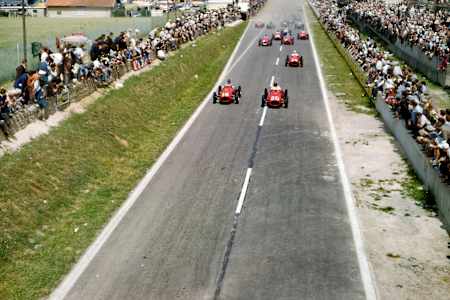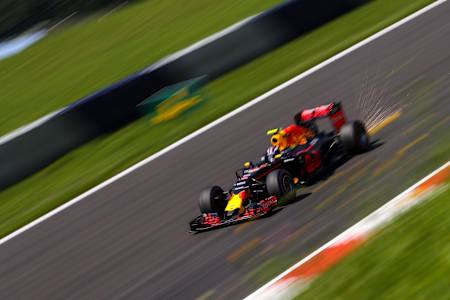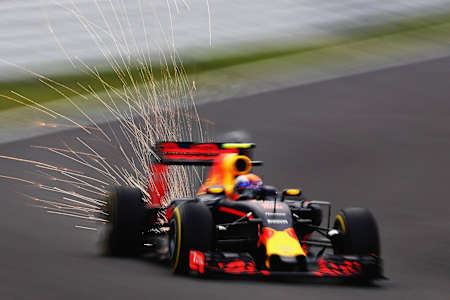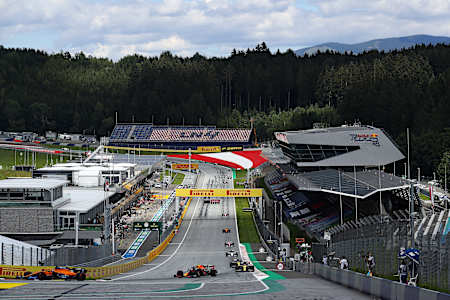Red Bull Motorsports
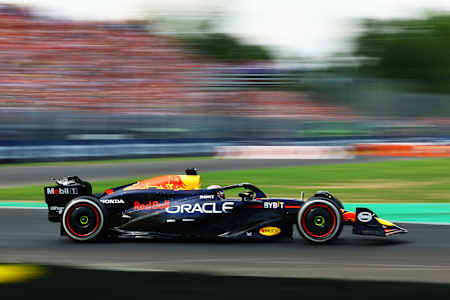
F1
How fast do F1 cars go?
These speeds are achieved through a combination of cutting-edge aerodynamics, powerful hybrid engines and advanced tire technology.
The high-octane, high-speed action of Formula 1 racing attracts spectators around the world. For fans and enthusiasts, there’s nothing like the allure of watching F1 cars zip around tracks at a breakneck pace. The quest for speed is integral to the sport, a relentless pursuit of shaving milliseconds off lap times and pushing the limits of automotive engineering.
Events like the Red Bull Energy Station Las Vegas exemplify the electrifying atmosphere surrounding F1. There’s no better way to see how fast F1 cars go in person. Learn more about F1’s top speeds here.
01
Top speed of F1 cars
Drivers consistently break top F1 speed records with every race.
Currently, F1 cars average between 210 and 220 miles per hour (mph) maximum, but higher speeds have been recorded in speed trap readings. Valtteri Bottas holds the top F1 speed of all time at 231 mph. He reached this milestone at the 2016 Mexican Grand Prix during a practice session while driving a Williams FW36. These speeds are achieved through a combination of cutting-edge aerodynamics, powerful hybrid engines, and advanced tire technology.
Historically, F1 cars have undergone significant evolution in terms of speed. In the early days of F1, cars like Jack Brabham’s T51 car achieved a top speed of 180 mph in the late 1950s. Over the decades, advancements in technology and changes in regulations have steadily increased these speeds. The first car to hit 200 mph was the Lotus 49 in 1968. By the 2000s, driver speeds were regularly exceeding 200 mph.
F1 speeds vs. other racing disciplines
When compared to other racing series, F1 cars are among the fastest. IndyCars, for instance, can reach similar top speeds of 230 mph or more, especially on oval tracks. But it takes IndyCars longer to reach those top speeds in comparison to F1 cars. MotoGP can also achieve maximum speeds of more than 200 mph. Like IndyCars, though, MotoGP cars can’t accelerate to top speed as fast as F1 cars can. NASCAR vehicles, on the other hand, top out just before 200 mph on super speedways.
The difference in speeds is partly due to the tracks themselves, the distinct designs, and regulations governing each racing series. F1’s emphasis on aerodynamics and downforce allows for remarkable cornering speeds and overall performance.
02
Factors affecting F1 car speed
Aerodynamics
Aerodynamics play a crucial role in determining the speed and performance of F1 cars. The intricate design of the front and rear wings and the underbody help to generate downforce. This keeps the car planted on the track while having minimal air resistance. The downforce allows for higher cornering speeds and improved stability. The trade-off, however, is drag, which engineers work to minimize.
Engine power and performance
Modern F1 cars are powered by turbocharged hybrid engines, known as power units. These power units consist of a 1.6-liter V6 internal combustion engine coupled with an energy recovery system (ERS). The ERS captures energy from braking and exhaust gasses, providing an additional power boost. The combined output can exceed 1,000 horsepower, allowing drivers to achieve their extraordinary speeds.
Tire technology
The right tire compounds can significantly impact lap times. Pirelli, Formula 1’s official tire supplier, designs tires to optimize grip and durability under different track conditions. The softer compounds offer better grip but wear out faster, while harder compounds last longer but provide less traction.
Car weight and design
An F1 car’s overall design, including its center of gravity and weight distribution, affects handling and speed, particularly around corners. Teams strive to build the lightest chassis structure possible, using materials like carbon fiber to maximize performance. The weight of an F1 car has to be a minimum of 798 kg, not counting driver or fuel. This is set to change in 2026, when FIA (Federation Internationale de l'Automobile) regulations will decrease the required weight to 768 kg.
03
Acceleration and lap times
An F1 car typically accelerates from 0 to 60 mph in about 2.1 to 2.7 seconds — but it has the ability to reach 60 mph in just 1.6 seconds. During races, lap times vary depending on the circuit but usually range from one to around 1.5 minutes. For example, at the 2021 Circuit de Monaco, known for its tight and twisty layout, Charles Leclerc completed a lap time of 1 minute and 10.346 seconds. On longer circuits like Monza in Italy, lap times are closer to 1 minute 20 seconds, with high average speeds.
When comparing acceleration to other high-performance vehicles, F1 isn’t always the fastest but these cars do still standout for high performance. Supercars like the Bugatti Chiron can achieve similar 0-60 mph times. But F1 cars excel in their ability to maintain high speeds through corners, thanks to their superior aerodynamics and downforce.
IndyCars only need 3 seconds to reach 90 mph and are faster in straight lines, but F1 cars excel on speed when it’s time to complete an entire lap. To get a side-by-side comparison, F1 raced IndyCar at the Circuit of America in 2019. IndyCar averaged 186.349km/h, hitting 1 minute and 46.018 seconds for pole time, whereas F1 averaged 206.374km/h, at one minute and 32.029 seconds for pole time. NASCAR vehicles, on the other hand, take 3.4 seconds to go from 0 to 60 mph and reach a maximum speed of 200 mph.
04
Speed records in F1
Record breaking drivers
Juan Pablo Montoya holds the Guinness World Record for the highest speeds ever recorded in a Grand Prix. His McLaren-Mercedes reached a top speed of 231.5 mph during the 2005 Italian Grand Prix at Monza.
Legendary drivers such as Lewis Hamilton, Michael Schumacher, and Fernando Alonso have also left their mark with record-breaking milestones. Hamilton holds the record for the most pole positions and race wins — both have reached over 100. Schumacher accumulated win after win, dominating the early 2000s to set new benchmarks for race pace and consistency.
But once Alonso started racing, he broke Schumacher’s five-world championship streak. Alonso also became the youngest driver to win a championship, and the youngest to score back-to-back championships.
Fastest laps and circuits
Every year drivers challenge themselves to beat the best times and become the fastest on the track. One of the fastest lap times in history was at the Austrian (& Styrian) Grand Prix’s Red Bull Ring in 2020 with Carlos Sainz marking 1:05.619.
Formula One Grand Prix of Styria 2020 at Red Bull Ring in Austria
© Getty Images / Red Bull Content Pool
Three years later, F1 driver Max Verstappen hit a 1:16.330 speedy lap at the 2023 Spanish Grand Prix’s Circuit de Barcelona-Catalunya. Verstappen shows although he couldn’t beat Sainz’s speed possibly due to the different tracks, he claims the fastest Circuit de Barcelona-Catalunya time — still making history.
When it comes to the speediest circuits, the Circuit de Spa-Francorchamps in Belgium has a reputation for high-speed sections, where drivers can reach speeds around 200 mph. As one of the fastest tracks on the F1 calendar, drivers are sure to bring their A-game and put on a show.
The need for speed continues
Formula 1 continues to push the boundaries of speed and performance, captivating fans with its blend of cutting-edge technology and thrilling racing. The pursuit of speed is not just about the numbers but also the innovation and passion that drive the sport forward. As F1 evolves and drivers push the limits of top speeds even further one thing remains certain. The fascination with how fast F1 cars can go will remain at the heart of its appeal.




